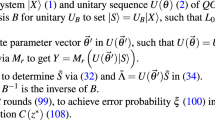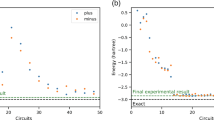Abstract
The paradigm of measurement-based quantum computation opens new experimental avenues to realizing a quantum computer, and also deepens our understanding of quantum physics. Measurement-based quantum computation originates with a highly entangled universal resource state. For years, clusters states have been the only known universal resources. Surprisingly, a novel framework, namely quantum computation in correlation space, has opened a new route to implementing measurement-based quantum computation based on quantum states having entanglement properties, which differ from cluster states. Here, we report an experimental demonstration of every building block of such a model. With four-qubit and six-qubit states, which are not in the cluster-state category, we have realized a universal set of single-qubit rotations, two-qubit entangling gates and also Deutsch's algorithm. As well as being of fundamental interest, our experiment proves, in principle, the feasibility of universal measurement-based quantum computation without the use of cluster states, which represents a new approach towards the realization of a quantum computer.
This is a preview of subscription content, access via your institution
Access options
Subscribe to this journal
Receive 12 print issues and online access
$209.00 per year
only $17.42 per issue
Buy this article
- Purchase on Springer Link
- Instant access to full article PDF
Prices may be subject to local taxes which are calculated during checkout




Similar content being viewed by others
References
Raussendorf, R. & Briegel, H. J. A one-way quantum computer. Phys. Rev. Lett. 86, 5188–5191 (2001).
Briegel, H. J. & Raussendorf, R. Persistent entanglement in arrays of interacting particles. Phys. Rev. Lett. 86, 910–913 (2001).
Briegel, H. J., Browne, D. E., Dür, W, Raussendorf, R. & Van den Nest, M. Measurement-based quantum computation. Nature Phys. 5, 19–26 (2009).
Walther, P. et al. Experimental one-way quantum computing. Nature 434, 169–176 (2005).
Kiesel, N. et al. Experimental analysis of a four-qubit photon cluster state. Phys. Rev. Lett. 95, 210502 (2005).
Lu, C-Y. et al. Experimental entanglement of six photons in graph states. Nature Phys. 3, 91–95 (2007).
Tokunaga, Y., Kuwashiro, S., Yamamoto, T., Koashi, M. & Imoto, N. Generation of high-fidelity four-photon cluster state and quantum-domain demonstration of one-way quantum computing. Phys. Rev. Lett. 100, 210501 (2008).
Vallone, G., Pomarico, E., De Martini, F. & Mataloni, P. Active one-way quantum computation with two-photon four-qubit cluster states. Phys. Rev. Lett. 100, 160502 (2008).
Hein, M. et al. in Quantum Computers, Algorithms and Chaos, Proceedings of the International School of Physics Enrico Fermi, Course CLXII (eds Casati, G., Shepelyansky, D. L., Zoller, P. & Benenti, G.) 115–218 (IOS Press, 2006).
Gross, D. & Eisert, J. Novel schemes for measurement-based quantum computation. Phys. Rev. Lett. 98, 220503 (2007).
Gross, D. et al. Measurement-based quantum computation beyond the one-way model. Phys. Rev. A 76, 052315 (2007).
Gross, D. & Eisert, J. Quantum computational webs. http://arxiv.org/abs/0810.2542 (2010).
Vaucher, B., Nunnenkamp, A. & Jaksch, D. Creation of resilient entangled states and a resource for measurement-based quantum computation with optical superlattices. New J. Phys. 10, 023005 (2008).
Brennen, G. K. & Miyake, A. Measurement-based quantum computer in the gapped ground state of a two-body Hamiltonian. Phys. Rev. Lett. 101, 010502 (2008).
Eisert, J. Optimizing linear optics quantum gates. Phys. Rev. Lett. 95, 040502 (2005).
Kieling, K., O'Brien, J. L. & Eisert, J. On photonic controlled phase gates. New J. Phys. 12, 013003 (2010).
Lemr, K. et al. Experimental implementation of the optimal linear-optical controlled phase gate. http://arxiv.org/abs/1007.4797 (2010).
Politi, A., Cryan, M. J., Rarity, J. G., Yu, S. Y. & O'Brien, J. L. Silica-on-silicon waveguide quantum circuits. Science 320, 646–649 (2008).
Politi, A., Matthews, J. C. F. & O' Brien, J. L. Shor's quantum factoring algorithm on a photonic chip. Science 325, 1221 (2009).
Matthews, J. C. F., Politi, A., Stefanov, A. & O'Brien, J. L. Manipulating multi-photon entanglement in waveguide quantum circuits. Nature Photon. 3, 346–350 (2009).
Verstraete, F. & Cirac, J. I. Valence-bond states for quantum computation. Phys. Rev. A 70, 060302 (2004).
Nielsen, M. A. Cluster-state quantum computation. Rep. Math. Phys. 57, 147–161 (2006).
Bartlett, S. D. & Rudolph, T. Simple nearest-neighbor two-body Hamiltonian system for which the ground state is a universal resource for quantum computation. Phys. Rev. A 74, 040302 (2006).
Chen, X., Zeng, B., Gu, Z-C., Yoshida, B. & Chuang, I. L. Gapped two-body Hamiltonian whose unique ground state is universal for one-way quantum computation. Phys. Rev. Lett. 102, 220501 (2009).
Van den Nest, M. et al. Universal resources for measurement-based quantum computation. Phys. Rev. Lett. 97, 150504 (2006).
Gross, D., Flammia, S. T. & Eisert, J. Most quantum states are too entangled to be useful as computational resources. Phys. Rev. Lett. 102, 190501 (2009).
Bremner, M., Mora, C. & Winter, A. Are random pure states useful for quantum computation? Phys. Rev. Lett. 102, 190502 (2009).
Cai, J.-M., Dür, W., Van den Nest, M., Miyake, A. & Briegel, H. J. Quantum computation in correlation space and extremal entanglement. Phys. Rev. Lett. 103, 050503 (2009).
Fannes, M., Nachtergaele, B. & Werner, R. F. Finitely correlated states on quantum spin chains. Commun. Math. Phys. 144, 443–490 (1992).
Perez-Garcia, D., Verstraete, F., Wolf, M. M. & Cirac, J. I. Matrix product state representations. Quantum. Inf. Comput. 7, 401–430 (2007).
Kwiat, P. G. et al. New high-intensity source of polarization-entangled photon pairs. Phys. Rev. Lett. 75, 4337–4341 (1995).
Ralph, T. C., Langford, N. K., Bell, T. B. & White, A. G. Linear optical controlled-NOT gate in the coincidence basis. Phys. Rev. A 65, 062324 (2002).
Hofmann, H. F. & Takeuchi, S. Quantum phase gate for photonic qubits using only beam splitters and postselection. Phys. Rev. A 66, 024308 (2002).
O'Brien, J. L., Pryde, G. J., White, A. G., Ralph, T. C. & Branning, D. Demonstration of an all-optical quantum controlled-NOT gate. Nature 426, 264–267 (2003).
Langford, N. K. et al. Demonstration of a simple entangling optical gate and its use in Bell-state analysis. Phys. Rev. Lett. 95, 210504 (2005).
Kiesel, N. et al. Linear optics controlled-phase gate made simple. Phys. Rev. Lett. 95, 210505 (2005).
Okamoto, R., Hofmann, H. F., Takeuchi, S. & Sasaki, K. Demonstration of an optical quantum controlled-NOT gate without path interference. Phys. Rev. Lett. 95, 210506 (2005).
Gao, W. B. et al. Experimental demonstration of a hyper-entangled ten-qubit Schrödinger cat state. Nature Phys. 6, 331–335 (2010).
Kalasuwan, P. et al. A simple scheme for expanding photonic cluster states for quantum information. J. Opt. Soc. Am. B 27, A181–A184 (2010).
Gisin, N. & Massar, S. Optimal quantum cloning machines. Phys. Rev. Lett. 79, 2153–2156 (1997).
Mohseni, M. et al. Experimental application of decoherence-free subspaces in an optical quantum-computing algorithm. Phys. Rev. Lett. 91, 187903 (2003).
Tame, M. S. et al. Experimental realization of Deutsch's algorithm in a one-way quantum computer. Phys. Rev. Lett. 98, 140501 (2007).
Deutsch, D. & Jozsa, R. Rapid solution of problems by quantum computation. Proc. Roy. Soc. Lond. A 439, 553–558 (1992).
Varnava, M., Browne, D. E. & Rudolph, T. How good must single photon sources and detectors be for efficient linear optical quantum computation? Phys. Rev. Lett. 100, 060502 (2008).
Wei., Z.-H., Han, Y.-J., Oh, C. H. & Duan, L.-M. Improving noise threshold for optical quantum computing with the EPR photon source. Phys. Rev. A 81, 060301 (2010).
Gross, D., Kieling, K. & Eisert, J. Potential and limits to cluster-state quantum computing using probabilistic gates. Phys. Rev. A 74, 042343 (2006).
Prevedel, R. et al. High-speed linear optics quantum computing using active feed-forward. Nature 445, 65–69 (2007).
Acknowledgements
The authors thank H.J. Briegel for valuable suggestions and J. Eisert for helpful discussions. This work is supported by the National Natural Science Foundation (NNSF) of China, the Chinese Academy of Sciences (CAS), the National Fundamental Research Program (under grant no. 2006CB921900), and the Fundamental Research Funds for the Central Universities. The research at Innsbruck is supported by the Austrian Science Fund (FWF) (J.-M.C. through the Lise Meitner Program, Special Research Area-Foundations and Applications of Quantum Science (SFB-FoQuS)).
Author information
Authors and Affiliations
Contributions
W.-B.G., J.-M.C., Z.-B.C. and J.-W.P. conceived the research. W.-B.G., X.-C.Y., H.L., P.X., T.Y., C.-Y.L. and Y.-A.C. carried out the experiment. W.-B.G., X.-C.Y., J.-M.C., H.L. and P.X. analysed the data. W.-B.G., J.-M.C., C.-Y.L. Y.-A.C. and J.-W.P. wrote the paper. J.-W.P. and Z.-B.C. supervised the entire project.
Corresponding authors
Ethics declarations
Competing interests
The authors declare no competing financial interests.
Supplementary information
Rights and permissions
About this article
Cite this article
Gao, WB., Yao, XC., Cai, JM. et al. Experimental measurement-based quantum computing beyond the cluster-state model. Nature Photon 5, 117–123 (2011). https://doi.org/10.1038/nphoton.2010.283
Received:
Accepted:
Published:
Issue Date:
DOI: https://doi.org/10.1038/nphoton.2010.283
This article is cited by
-
Deterministic multi-mode gates on a scalable photonic quantum computing platform
Nature Physics (2021)
-
Deterministic tripartite sharing of an arbitrary single-qubit operation with the five-qubit cluster state in a given entanglement structure
Quantum Information Processing (2021)
-
Experimental demonstration of a graph state quantum error-correction code
Nature Communications (2014)



